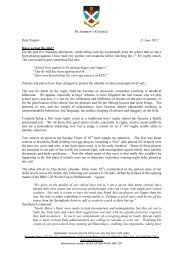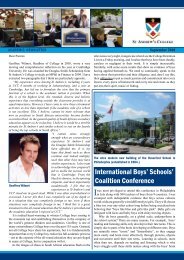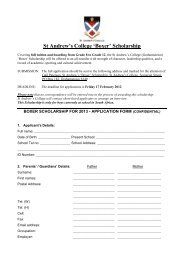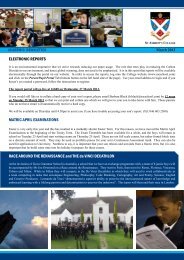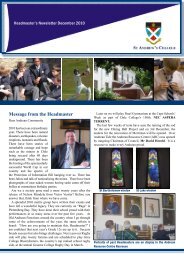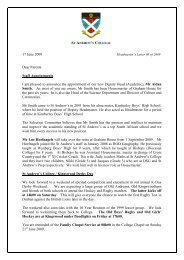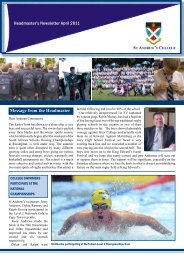Methods and Techniques
Methods and Techniques
Methods and Techniques
- No tags were found...
Create successful ePaper yourself
Turn your PDF publications into a flip-book with our unique Google optimized e-Paper software.
ANDY WARHOL’SMETHODS AND TECHNIQUES“I want to be a machine.”-Andy WarholTHE ANDYWARHOLMUSEUM
Collaboration: Working with OthersAndy Warhol collaborated with many people to make his art work. The first person to assist <strong>and</strong>work along side him was his mother, Julia Warhola. Later, Warhol collaborated with other artistssuch as choreographer Merce Cunningham, composer John Cage, <strong>and</strong> painter Jean-MichelBasquiat. He hired assistants to help him with studio processes like silkscreening <strong>and</strong> photographythroughout his career. Warhol’s instructions to his assistants were frequently <strong>and</strong> intentionallyvague. Sometimes Warhol enjoyed the results when his assistants misinterpreted his instructions.Ultimately, it was Warhol who made the final decisions regarding form <strong>and</strong> content, by constantlydefining his production parameters, surveying them <strong>and</strong> always approving final products.Andy Warhol was very interested in exploring new technology <strong>and</strong> media in his art. He tried newtechnologies as they became available, including synthetic polymer paint, audio-taping interviews,instant Polaroid film, video production for MTV <strong>and</strong> computers. His interest in technology ledWarhol to try many mediums <strong>and</strong> to easily cross traditional boundaries from one medium to another.He was a painter, a commercial artist, a filmmaker, a music producer, <strong>and</strong> a publisher as well as acelebrity. It was Andy Warhol’s willingness to experiment <strong>and</strong> explore that made his work so innovative.Below are two of the most asked about techniques employed by Andy Warhol.Blotted Line DrawingAndy Warhol first started experimenting with a special type of line drawing known as the blotted linetechnique while still a college student at Carnegie Tech. He later used it to great effect in hiscommercial art of the 1950’s.The blotted line technique is actually a very simple print making process. Warhol started his blottedline drawings by making a pencil line drawing on nonabsorbent paper. He would then hinge thedrawing to a second sheet of more absorbent Strathmore paper. With an old fountain pen, Warholinked over the pencil lines on the original drawing. Then the second sheet of paper was foldedalong the hinge <strong>and</strong> the freshly inked lines were transferred by simply pressing the papers together.Large drawings were done in sections. Completing a blotted line drawing might take quite a bit oftime <strong>and</strong> multiple pressings. The process resulted in the stylistically broken <strong>and</strong> hesitant linesthat are characteristic of Andy Warhol’s illustrations. Warhol often colored his blotted linedrawings with watercolor dyes or gold leaf.Photo SilkscreenAndy Warhol’s use of photo silkscreen was innovative because it is a technique traditionally usedfor mass production for commercial purposes. Photo silkscreen is a printmaking technique thatallowed Warhol to repeat images over <strong>and</strong> over. Warhol used photo silkscreen to create some ofhis most famous works of art.Andy Warhol would send photographs taken by himself or others to a commercial silkscreen shopto have the photographic images transferred to silkscreens. At the commercial silkscreen shop,black <strong>and</strong> white or high-contrast color photographs were projected onto sheer silk or silk-like fabricstretched over a frame. The screen was first coated with a light-sensitive emulsion that hardened inthe areas where it was exposed to light. The emulsion that was not exposed to light did not harden
<strong>and</strong> was then rinsed off leaving clear fabric. The pattern of light <strong>and</strong> dark from the projected imagewas thereby fixed on the screen.To reproduce the image on paper or canvas, paint or printer’s ink was applied through the screen.The paint was pushed across the screen’s surface with a rubber blade called a squeegee. Thesqueegee forced the paint through the screen, but only in the unblocked areas. An even layer oftiny dots of paint came through the woven threads creating the printed image.At the commercial silkscreen shop, Andy Warhol could have his images enlarged or reduced ontoscreens of almost any size. Once the prepared silkscreen was returned to Warhol from the shop,Warhol could print the images directly onto unstretched canvases which were usually laid out onthe floor. The canvases were primed in advance <strong>and</strong> sometimes painted with solid color backgrounds.Often the canvases were h<strong>and</strong>-painted with colors that Warhol thought matched thedepicted image such as skin tones <strong>and</strong> vibrant magenta eye shadow before the screened imagewas applied. Occasionally Warhol painted on top of his silkscreened images but usually thesilkscreen served as a final defining layer.Filmmaking <strong>Techniques</strong>Andy Warhol became well known in the New York underground film community for his minimalistfilms. Warhol’s black <strong>and</strong> white 16mm films had a unique visual vocabulary. The unit of productionwas often a 33 minute reel of film, rather than content. His early films were long <strong>and</strong> static. Hisfamous film Empire is eight hours long, but the filming itself took six hours. To achieve his desiredeffect Warhol actually slowed down the film. He used a tripod to set up a single shot, stationarycamera position <strong>and</strong> thus a paradox between still duration <strong>and</strong> film’s natural application to recordmovement. This method of filmmaking was often used in many of Warhol’s portrait films. Warhol’searliest films may seem technologically primitive, but they are examinations of films’s purest formwithout an attempt to create a new reality.Warhol’s first films were silent, but later when he bought a camera that recorded sound, he beganto experiment with narrative techniques <strong>and</strong> dialogue. The films would often interrupt a sequence ofevents already in progress. Warhol allows the audience only a splice of time. In the tradition ofavant-guard performance work, Warhol wanted his films to have an element of chance <strong>and</strong> wouldfrequently sabotage his own productions, often by not allowing the actors to read the scripts beforefilming, or only giving half the cast directions to see <strong>and</strong> record as finished product what occurred.Like his earlier films, the later films were calculated in their simplicity using little editing or cameramanipulation. Warhol’s early films were rarely edited. His one editing method was his trademarktechnique called ‘strobe cutting.’ The ‘strobe cut’ is a form of in-camera editing in which the camerais rapidly turned off <strong>and</strong> on again. This simple act creates a clear frame then a double exposedframe <strong>and</strong> then an electronic bloop on the sound track.





